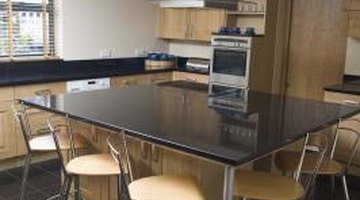How to Secure Kitchen Cabinets to the Floor
You don't need to secure kitchen cabinets to the floor if they run along a wall. Instead, drill screws through the back of these cabinets into the studs behind the wall. But free-standing kitchen cabinets, such as kitchen islands and breakfast bars, do need to be anchored to the floor with screws so they don't move. To accomplish this, screw wooden blocks to the floor and attach the cabinets to the wooden blocks.

-
Put the kitchen island cabinet in place, leaving a standing space of at least 3 feet between it and the wall cabinets.
-
Use a pencil to mark the floor along the outside bottom edge of the cabinet.
-
Measure the thickness of the piece of wood at the bottom of the kitchen cabinet. You later will secure this piece of wood, known as toe kick, to the wooden blocks. The toe kick usually is 3/8 to 1/2 inch thick.
-
Draw a smaller outline inside the outline you drew in Step 2, leaving a space as wide as the thickness of the toe kick between the two parallel lines.
-
Measure the dimensions of the outline and cut wooden 2-by-4 blocks to fit inside the outline.
-
Lay the wooden blocks along the smaller outline you drew on the floor. Drill screw holes through the blocks and the flooring to prevent damage to the floor. Different flooring materials need different drill bits. For example, masonry drill bits work with masonry, tile and marble. Brad-point, spade-type and Forstner bits can all drill through wood and other soft materials.
-
Align the drilled holes in the blocks with the holes in the floor. Drive screws through the wooden blocks and into the floor.
-
Place the cabinet over the wooden blocks and drive screws through the toe kicks and into the blocks to secure the cabinet to the floor.
References
Writer Bio
Edriaan Koening began writing professionally in 2005, while studying toward her Bachelor of Arts in media and communications at the University of Melbourne. She has since written for several magazines and websites. Koening also holds a Master of Commerce in funds management and accounting from the University of New South Wales.
Photo Credits
- Jupiterimages/Comstock/Getty Images
More Articles



